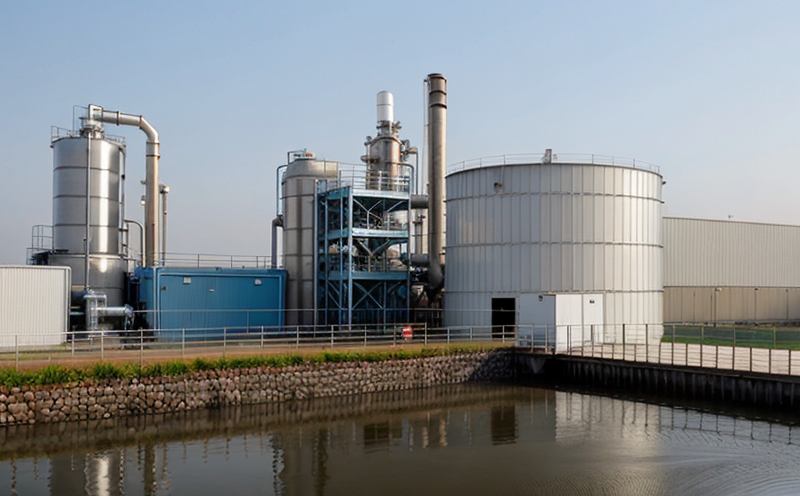ISO 16266 Pseudomonas aeruginosa Testing in Industrial Water
The presence of Pseudomonas aeruginosa in industrial water systems can lead to significant operational challenges and economic losses. This bacterium is a versatile opportunist, capable of thriving in diverse environments including industrial processing facilities where its contamination can disrupt production processes and compromise product quality.
ISO 16266 outlines the procedures for the identification and enumeration of Pseudomonas aeruginosa. This standard provides a robust framework to ensure accurate detection and quantification, which is crucial for maintaining water quality standards. In industrial settings, such as manufacturing plants or chemical processing facilities, water contamination can lead to increased corrosion rates, biofilm formation, and the degradation of equipment and materials.
The testing method described by ISO 16266 involves several key steps: sampling, culture isolation, identification using biochemical tests, and confirmation through molecular methods. The process aims for precision and reliability, ensuring that any presence or absence of Pseudomonas aeruginosa is accurately reported.
The importance of this testing cannot be overstated in maintaining a healthy industrial water environment. By adhering to ISO 16266, facilities can mitigate risks associated with microbial contamination, thereby enhancing operational efficiency and product quality. This not only supports compliance with regulatory standards but also ensures the long-term sustainability of industrial operations.
In summary, implementing ISO 16266 testing is essential for quality assurance in industrial water systems. It provides a standardized approach to detecting Pseudomonas aeruginosa, which can help prevent costly disruptions and ensure that facilities are operating within the required health and safety standards.
| Use Case | Description |
|---|---|
| Water Quality Monitoring | Continuous monitoring to identify potential contamination early, allowing for swift corrective actions. |
| New Facility Commissioning | Testing during the startup phase ensures compliance with initial quality benchmarks and sets a baseline for future performance. |
| Routine Maintenance | Regular testing helps in identifying issues before they escalate, thus reducing maintenance costs and downtime. |
| Preventive Measures | Testing can help identify trends that indicate potential problems, enabling proactive management strategies. |
| Regulatory Compliance | Meeting regulatory requirements ensures ongoing compliance and avoids penalties for non-compliance. |
| Investigation of Incidents | Post-incident testing can help determine the cause of contamination, aiding in effective remediation strategies. |
| Sustainability Initiatives | Testing supports sustainability goals by ensuring water quality standards are met, thus promoting resource efficiency. |
| New Product Development | Ensuring product formulation stability and preventing potential contamination risks during development phases. |
Why It Matters
The significance of ISO 16266 testing in industrial water cannot be overstated. Contamination by Pseudomonas aeruginosa can have severe implications for industrial operations, affecting not only the quality of products but also the integrity of equipment and infrastructure.
In terms of operational efficiency, contamination can lead to increased downtime due to equipment malfunctions caused by biofilm formation. This can result in significant financial losses and production delays. Moreover, the presence of this bacterium can compromise product quality, leading to recalls or even legal disputes. Compliance with standards like ISO 16266 is thus essential for maintaining a robust quality control process.
From an environmental perspective, minimizing contamination helps in reducing waste generation and promoting sustainable practices within industrial processes. By ensuring that water systems are free from harmful bacteria, facilities contribute to a healthier ecosystem and comply with broader sustainability goals. This also reflects positively on the facility's reputation and its commitment to responsible resource management.
From a regulatory standpoint, adherence to ISO 16266 ensures compliance with local and international standards for water quality. Non-compliance can lead to stringent penalties and reputational damage. By investing in regular testing, facilities demonstrate their commitment to maintaining high-quality industrial water systems, thereby safeguarding both internal operations and external stakeholder trust.
In conclusion, the implementation of ISO 16266 testing is not merely a compliance exercise but a critical component of effective quality management. It ensures that industrial water systems are safe, reliable, and capable of supporting sustainable and efficient operations.
Why Choose This Test
Selecting ISO 16266 testing for Pseudomonas aeruginosa in industrial water offers several advantages that are crucial for maintaining high-quality standards. This method is specifically designed to provide accurate and reliable results, ensuring that facilities can trust the outcomes of their tests.
The robustness of ISO 16266 lies in its standardized procedures, which minimize variability and ensure consistency across different laboratories. This standardization is particularly important for industrial environments where precise and replicable testing is essential to maintain operational integrity. The method's ability to detect Pseudomonas aeruginosa at low levels ensures that even minor contamination can be identified early, allowing for timely interventions.
A key advantage of this test is its versatility. It can be adapted to various industrial settings, from food and beverage processing plants to chemical manufacturing facilities. This adaptability makes it a valuable tool for maintaining consistent water quality across diverse operational environments. The method's precision also allows for the identification of specific strains of Pseudomonas aeruginosa, which can help in understanding the source of contamination and implementing targeted remediation strategies.
Moreover, ISO 16266 testing supports regulatory compliance by ensuring that facilities meet stringent water quality standards. This not only protects against potential legal issues but also enhances the facility's reputation as a leader in environmental stewardship. By choosing this test, industrial facilities can demonstrate their commitment to maintaining high-quality water systems and fostering a sustainable operational environment.
In summary, ISO 16266 testing is an essential tool for industrial facilities seeking to maintain optimal water quality and operational efficiency. Its standardized procedures, adaptability, and precision make it the preferred choice for ensuring reliable and accurate results in Pseudomonas aeruginosa detection.





